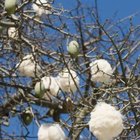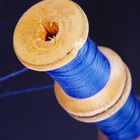
Hemera Technologies/AbleStock.com/Getty Images
Take a look at your favorite T-shirt--is it shapeless and baggy or does it look like you just bought it? Changes are if you identify with the latter, it has a blend of Lycra in it. As a consumer, it is important to know about fabrics and their properties to ensure you are maximizing your money.
Cotton
According to cotton.org, no one is for certain how old cotton itself is. In 1730 it was first spun in a machinery in London. Since then, cotton has been a economic powerhouse. Cotton comes from a shrubby plant; it is first picked, cleaned and then spun into a fabric, known as cotton.
Lycra
Lycra is a registered trademark of INVISTA, formally known as DuPont. Lycra was first developed in the late 1950s as an alternative to rubber. It is a man- made fiber that is never used by itself but blends well with other fabrics such as cotton, silk and other synthetic fibers.
Differences
Lycra has a stretch property cotton lacks; this allows for a Lycra blended item to retain its shape and not sag or sag. Therefore, Lycra is becoming more popular to manufacture clothes with because of its durability. Cotton has a tendency to wrinkle while Lycra is commonly used in no-iron shirts.
Lycra is quick drying, making this fabric ideal in swimwear and outdoor apparel. Cotton comes from a plant, while Lycra is man-man, or synthetic. Generally Lycra is cheaper to produce than cotton, making the demand for synthetic goods higher.
Blends
A majority of clothing, ranging from jeans to sweaters to undergarments, have a minimum of 2 percent Lycra blend. This allows comfort from the cotton but sustainability from the Lycra.
Cotton and Lycra blended clothing also allows for a flattering fit due to the molding property of Lycra. Many designers or clothing brands prefer to add Lycra to a cotton garment because it flatters and fits the body while cotton is generally shapeless.
Future
Up until the 2000s Lycra was only used in textiles. That all changed when Lycra partnered with the cosmetics company Rimmel to produce a line of nail polishes containing the fiber. According to lycra.com, this blend helped keep the nail polish "shock resistant".
Cotton has seen a dip in demand due to the economy, however, more eco-friendly consumers are pushing for organically grown cotton. This means cotton is grown without pesticides or chemicals.
Related Articles

How Much of the World's Clothing Is ...

Characteristics of Polyester & Cotton

Spandex vs. Polyester

Uses of Cotton Fabric

Denim vs. Denim Blends

Twill vs a Cotton-Polyester Blend

About Polyester Cotton Blend

Properties of Cotton Fabric

List of Plants Used for Clothing

How to Care for Rayon and Spandex ...

Advantages & Disadvantages of Natural ...

Description and Characteristics of ...

What Is a Synthetic Polyester Fabric?

What Is Pinpoint Cotton?

The History of Polyester Fabric

What Is Arnel Vintage Material Fabric?

What Is Artificial Silk?

The Advantages & Disadvantages of Woven ...

The Advantages of Polyester Cotton

The History of Flame-Retardant Clothing
References
Writer Bio
Rachel Burton started writing professionally in 2008. Her work can be found in "Out N' About" newspaper. Burton has a Bachelor of Arts degree in English and sociology.
Photo Credits
Hemera Technologies/AbleStock.com/Getty Images